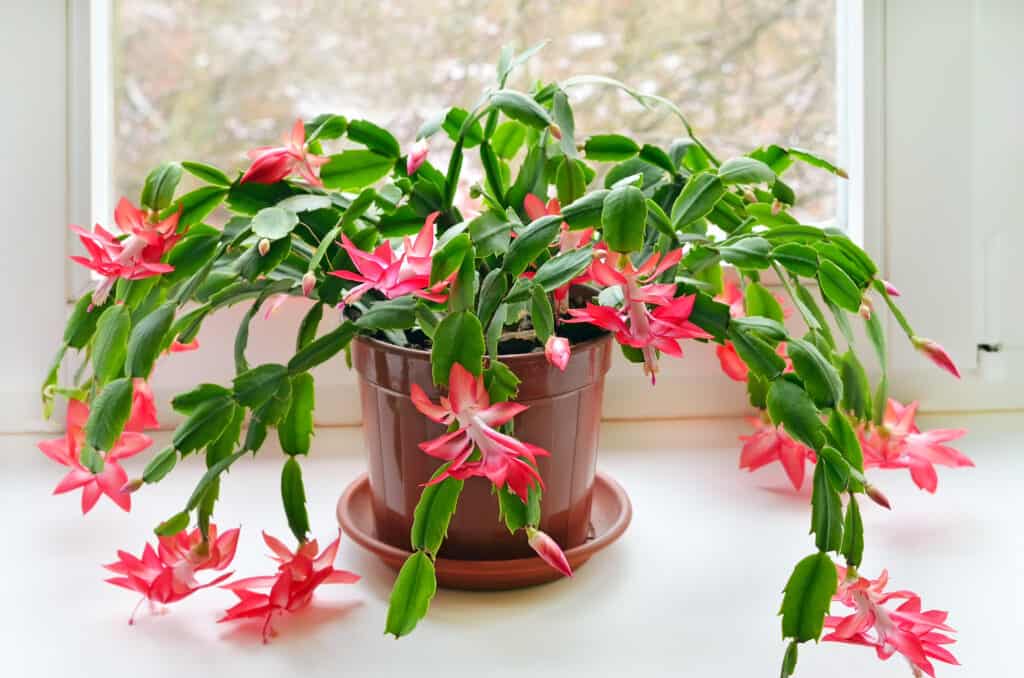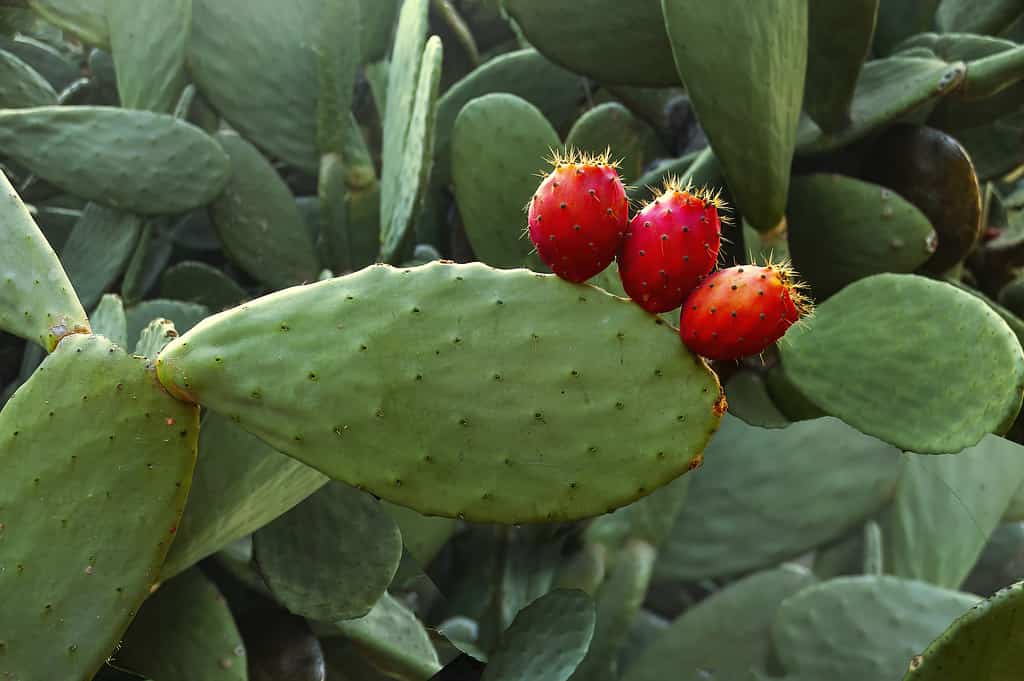Cacti are often associated with arid, desert landscapes. The thought of cacti may bring images of soaring saguaros and unique chollas to mind. But did you know that many cacti varieties thrive in Florida‘s humid climate? You may spot some when you are out driving around or spending time hiking your favorite trail. Or you may have wanted to plant some cacti of your own. If it is the latter, you can add some unique texture to your garden or plant Prickly Pear cactus for food. There are ample possibilities to expand the aesthetic of your outdoor landscaping. Below we’ll take a look at the cacti varieties that can thrive in Florida’s unique environment and how to care for them.

The Christmas cactus is popular during the holidays, but makes a lovely addition to your houseplant collection year-round.
©iStock.com/Nadezhda_Nesterova
Types of Cacti that Grow in Florida
Prickly Pear Cactus
The Prickly Pear (Opuntia humifusa) is an iconic cactus. And the best news is that it grows very well in Florida, so you can feel free to plant away. Prickly Pear has flat, paddle-shaped pads covered in spines and small hairs. During the summer, they develop gorgeous yellow blossoms that bees love. Prickly Pear is not purely ornamental, though. It has played an important role in traditional Mexican cuisine. The pads and the fruit are delicious and enjoyed in many forms.
Christmas Cactus
The delightful Christmas cactus (Schlumbergera spp.) is popular as a houseplant during the holiday season and does grow well in Florida. The cactus produces beautiful, colorful blooms that can last for several weeks. However, there is a catch. It won’t bloom until the weather starts to get a bit colder and the nights longer. Christmas cacti require a minimum of 12 hours of darkness for the lovely blossoms to develop.
Old Man Cactus
The Old Man Cactus (Cephalocereus senilis) is a slow-growing cactus that has become increasingly popular as a houseplant. It is covered in thin, long, white hairs, but don’t let the hairs fool you. They are composed of tiny thorns. So as lovely as the cactus is, it will “bite” if you get too close. This cactus species produces stunning yellow, red, or white flowers. But you may not get to see them for a decade or more.
Fishhook Barrel Cactus
Known as the Arizona barrel cactus, the Fishhook Barrel cactus (Ferocactus wislizeni) is native to the southwest portion of the United States and Northern Mexico. It can also grow successfully in Florida, however. Due to its size, it is best grown outdoors in a container or directly in the ground. This cactus is slowly growing, has a long lifespan, and produces lovely yellow flowers in the summer.
Bunny Ear Cactus
The aptly named Bunny Ear cactus (Opuntia microdasys) has small, fuzzy hairs resembling bunny ears. This compact cactus is actually spine-free, so it is safe to keep around tiny, curious hands if you have kids. The pads are yellow and light green. This cactus species do well in an indoor container or out in your garden.

The prickly pear cactus has edible fruit and pads.
©iStock.com/barbaraaaa
Tips for Growing Cacti in Florida
Choose the Right Location
Nearly all cacti are drought-tolerant and thrive in well-draining soil and full sun. However, sometimes the intense Florida heat may be a bit too much. So it is important to choose a good location that receives but also offers some protection in the hottest parts of the day.
Watering
While cacti are well-known for their drought tolerance, they still need water to survive. Watering your cacti regularly will keep them healthy and thriving. The important point to remember is that it is easy to overwater cacti. Making this common mistake may result in root rot. And not all cacti are the same. Some species require more frequent watering than others. Take the time to research your particular cactus to determine what level of watering it needs.
Fertilizer
The good news is that cacti don’t need a lot of fertilizer. That said, a light application of a balanced fertilizer in the spring can help promote healthy growth and blooms. If you are growing your cactus in a pot, you will want to look for a high-quality water-soluble fertilizer. And keep fertilizer applications to a minimum. Too many added nutrients can damage your cactus.
Soil
Cacti need well-draining soil low in organic matter. Depending on where in Florida you live, your soil may not meet that description. But never fear! There are steps you can take and amendments you can add to achieve the desired soil consistency. Consider adding sand, perlite, or vermiculite to improve drainage. The route you choose will ultimately get determined by the composition of your current soil. If you plan to plant your cactus in a pot, you can also purchase soil mixes specifically formulated for growing cacti.
Pests and Diseases
Cacti are generally resistant to pests and diseases, but they can still be affected by mealybugs, spider mites, and scale insects. Keep your cacti clean and free of debris to prevent pests from taking hold. If you start to notice pests, go ahead and treat your cactus with insecticidal soap or neem oil. Signs of possible diseases include black spots or soft spots on the pads. Remove any affected areas immediately to prevent the spread of the problem to the rest of the plant. Cacti are also prone to root rot when overwatered.
Mulch
Consider mulching the area around your cactus if you plant it in the garden. This step can help to retain moisture in the soil and prevent weeds from taking hold around your cactus. Opt for mulch low in organic matter, such as gravel, rocks, or sand. Avoid using organic mulches like bark or wood chips. These options retain moisture easily (which can lead to root rot).
Pruning
Thankfully, cacti are relatively easy to care for. They generally don’t require or need pruning. But removing any dead or damaged growth is an important part of promoting healthy growth. If you notice any diseased or damaged areas on your cactus, remove them immediately. Use sharp, clean shears and cut at a 45-degree angle to promote healing.
Propagation
If you love your cactus, feel free to propagate it! Take a cutting from a healthy plant and let it dry out for a few days before planting it in well-draining soil. Water the cutting sparingly until it establishes roots. Wait a few weeks before transplanting your new cactus so the roots have ample time to set.
Winter Care
If frost is in the forecast, you don’t have to worry about your cactus. Feel free to bring any container of cacti inside overnight to keep them sheltered from the cold. However, there are also steps you can take if your cactus is planted in the garden. All it needs is a blanket or frost cloth to keep it warm until the freezing temperatures pass.
Harvesting
This tip really only applies to the delicious Prickly Pear. If you have chosen to grow Prickly Pear cacti for food, it is important to know when (and what) to harvest. The pads should get harvested when they are young and tender. Wear thick gloves to protect your hands from the spines, and use a sharp knife to cut the pads from the plant. Always remove the spines and hairs before cooking or eating. If you want to make some prickly pear jelly, keep a close watch on the prickly pear fruit. The best time to harvest them will be toward the end of summer. Prickly pear fruit will be a deep, beautiful color with no green remaining.

An old man cactus makes a unique and eye-catching addition to any home or garden.
©iStock.com/Leslie Quiroz
The photo featured at the top of this post is © iStock.com/yes
Thank you for reading! Have some feedback for us? Contact the AZ Animals editorial team.







